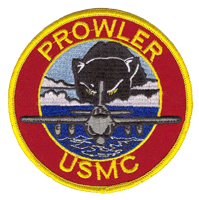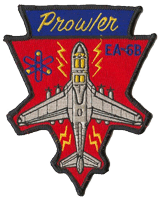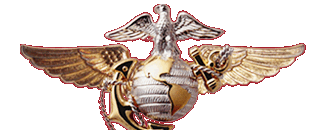MCARA Aircraft > EA-6B ICAP II
The EA-6B was a more advanced electronic warfare version of the A-6. Despite the fact that it used the same wing and fuselage configuration as the A-6 Intruder, it was in fact virtually a completely different aircraft. Consequently, it was given a new name--Prowler.
The ICAP (Improved Capability) configuration was introduced with the 54th production Prowler. Experience had shown that crew coordination between the two TJS operators was difficult and severely overtaxed the crew member in the right front seat, who was also responsible for navigation and communication.  In the ICAP configuration, there was a redistribution of the work among the three electronics countermeasures operators so that the tasks were more equally shared among them. The communication jamming function was relocated to the navigator's position, which was up front beside the pilot. The radar and other jamming functions were relocated to the two rear crew positions. The electronics response time was improved by digitally tuning the surveillance receivers. The AN/APS-130 search radar replaced the AN/APQ-129 set. New chaff dispensing pods were carried. An AN/ALQ-126A self-protection countermeasures set replaced the AN/ALQ-100. The AN/ALQ-126A had a set of receiver antennae located in the sawtooth at the leading edge of the refuelling probe and in a "beer can" extension at the rear of the fin cap equipment pod. The AN/ALQ-100 had been little used because it interfered with the TJS and was in addition rather unreliable. However, the AN/ALQ-126 system did very little to end the problem, so it was little utilized as well, the crew relying primarily on chaff and flares as defensive countermeasures. The new cockpit featured a digital display group, and the AN/APS-130 replaced the AN/APQ-129 search radar. New radios were added, and the AN/ALQ-92 communications jamming system was replaced by an interim AN/ALQ-191. The AN/ALQ-92 was seldom installed in the EA-6B and the operator sitting in the right front seat generally served primarily as a navigator. Even the AN/ALQ-191 system was not installed in every EA-6B. 45 production aircraft were delivered in the ICAP format, the first one flying in July of 1975. Deliveries began in July of 1976. In addition, 21 earlier production aircraft were upgraded to ICAP format.
In the ICAP configuration, there was a redistribution of the work among the three electronics countermeasures operators so that the tasks were more equally shared among them. The communication jamming function was relocated to the navigator's position, which was up front beside the pilot. The radar and other jamming functions were relocated to the two rear crew positions. The electronics response time was improved by digitally tuning the surveillance receivers. The AN/APS-130 search radar replaced the AN/APQ-129 set. New chaff dispensing pods were carried. An AN/ALQ-126A self-protection countermeasures set replaced the AN/ALQ-100. The AN/ALQ-126A had a set of receiver antennae located in the sawtooth at the leading edge of the refuelling probe and in a "beer can" extension at the rear of the fin cap equipment pod. The AN/ALQ-100 had been little used because it interfered with the TJS and was in addition rather unreliable. However, the AN/ALQ-126 system did very little to end the problem, so it was little utilized as well, the crew relying primarily on chaff and flares as defensive countermeasures. The new cockpit featured a digital display group, and the AN/APS-130 replaced the AN/APQ-129 search radar. New radios were added, and the AN/ALQ-92 communications jamming system was replaced by an interim AN/ALQ-191. The AN/ALQ-92 was seldom installed in the EA-6B and the operator sitting in the right front seat generally served primarily as a navigator. Even the AN/ALQ-191 system was not installed in every EA-6B. 45 production aircraft were delivered in the ICAP format, the first one flying in July of 1975. Deliveries began in July of 1976. In addition, 21 earlier production aircraft were upgraded to ICAP format.
 The ICAP II was a further improvement to the Prowler. The last pre-production Prowler (BuNo 156482) served as the developmental aircraft for the ICAP II and flew for the first time on June 24, 1980. The ICAP II produced some major improvements to the external pods. The TJS was upgraded to the AN/ALQ-99D configuration to cover a wider frequency range. The AN/ASQ-113 jamming system replaced the AN/ASQ-191. In earlier Prowlers, the jamming pods each generated signals within one frequency band and were not capable of being reconfigured in flight, but in ICAP II the pods could generate signals in any one of seven frequency bands, and each pod could jam in two different frequency bands simultaneously. The more advanced AN/AYK-14 computer replaced the earlier AYA-6. The AN/ASN-130 Carrier Inertial Navigation System (CAINS) was installed. There were improved displays for the crew members. Threat information was pre-programmed and automatically entered into an on-board computer. Also added was the ability for two Prowlers to link together via a TACAN datalink to work together in a coordinated electronic warfare mission. The ability to carry and launch the HARM antiradiation missile was incorporated with the 111th production article, and was retrofitted to earlier aircraft. The weapon's control panel was located at the right front navigator's position. Deliveries of the ICAP II Prowler began with the 99th production machine in January of 1984. All surviving ICAP I and ICAP Mod 1 aircraft were brought up to ICAP II standards.
The ICAP II was a further improvement to the Prowler. The last pre-production Prowler (BuNo 156482) served as the developmental aircraft for the ICAP II and flew for the first time on June 24, 1980. The ICAP II produced some major improvements to the external pods. The TJS was upgraded to the AN/ALQ-99D configuration to cover a wider frequency range. The AN/ASQ-113 jamming system replaced the AN/ASQ-191. In earlier Prowlers, the jamming pods each generated signals within one frequency band and were not capable of being reconfigured in flight, but in ICAP II the pods could generate signals in any one of seven frequency bands, and each pod could jam in two different frequency bands simultaneously. The more advanced AN/AYK-14 computer replaced the earlier AYA-6. The AN/ASN-130 Carrier Inertial Navigation System (CAINS) was installed. There were improved displays for the crew members. Threat information was pre-programmed and automatically entered into an on-board computer. Also added was the ability for two Prowlers to link together via a TACAN datalink to work together in a coordinated electronic warfare mission. The ability to carry and launch the HARM antiradiation missile was incorporated with the 111th production article, and was retrofitted to earlier aircraft. The weapon's control panel was located at the right front navigator's position. Deliveries of the ICAP II Prowler began with the 99th production machine in January of 1984. All surviving ICAP I and ICAP Mod 1 aircraft were brought up to ICAP II standards.
Beginning with P-134 (BuNo 163049), ICAP II planes were completed to "Block 86" standards, the 86 indicative of the fiscal year in which they were ordered. Earlier ICAP IIs were retroactively known as Block 82s. Changes included dual AN/ARC-182 UHF/VHF radios. "Block 86" planes can be identified by the presence of three new antennae on the dorsal spine of the fuselage and under the nose. Between 1983 and 1991, Grumman modified 15 EXCAP and 57 ICAP I Prowlers to ICAP II standards.
Prowler production came to an end with the delivery of the 170th example, BuNo 164403. It was delivered on July 29, 1991. All of the subsequent changes to the Prowler were by upgrades to existing aircraft.
History Coming Soon...


